Micron M510DC (480GB) Enterprise SATA SSD Review
by Kristian Vättö on July 21, 2015 8:00 AM ESTMixed 4KB Random
In real world, workloads are rarely just pure reads or writes, hence it's important to test mixed performance as it better illustrates the performance under an enterprise workload. The read/write distribution varies greatly depending on the workload, but 70% read and 30% write is often considered as the benchmark for mixed performance. It's a little write heavy to mirror the most read-centric workloads (like media streaming or cloud storage), but it's fairly realistic for mimicking virtual desktop infrastucture (VDI) workloads for example.
The test sequence is similar to the random write benchmark. I start off with a two-hour sequential write pass, which is followed by six hours of 4KB random IOs at QD32 with 70% being reads and 30% writes. I again record the results of the last 500 seconds to ensure that the results represent steady-state performance. I also test queue depth scaling after the six-hour run and as a final test I run a 4KB random IO test (QD32) at six different read/write distributions in order to determine performance for different workloads.
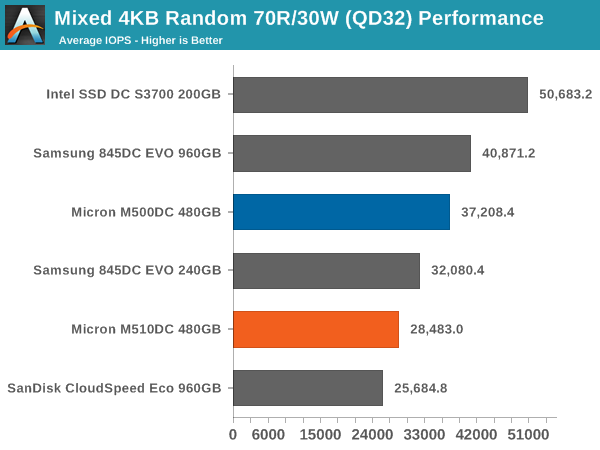
The 70R/30W mixed performance is a slight disappointment. While the M510DC deliver considerably higher random write performance than the 845DC EVO, it cannot match the EVO in mixed performance.
At low queue depths the M510DC actually provides better performance than the EVO, but after QD8 the performance no longer scales optimally, which is inherent in the design as the same scaling phenomenon is present in the M500DC as well.
The performance at different read/write distributions is overall good and on par with the CloudSpeed Eco and 240GB EVO. For performance-focused mixed workloads, the M500DC is a better option, although ultimately the S3700 easily takes the crown here.
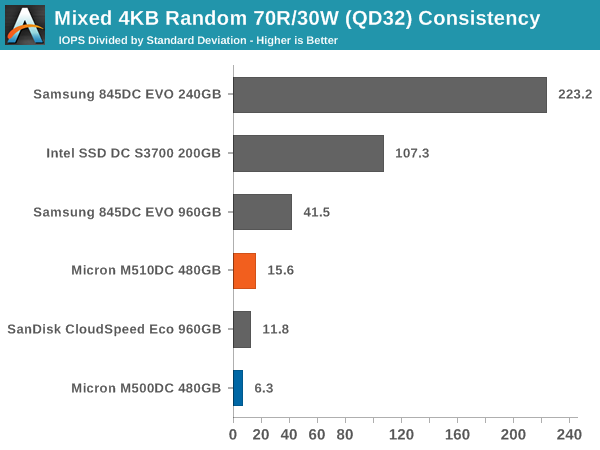
Consistency again leaves something to be desired because compared to the EVOs the M510DC isn't a very consistent drive.
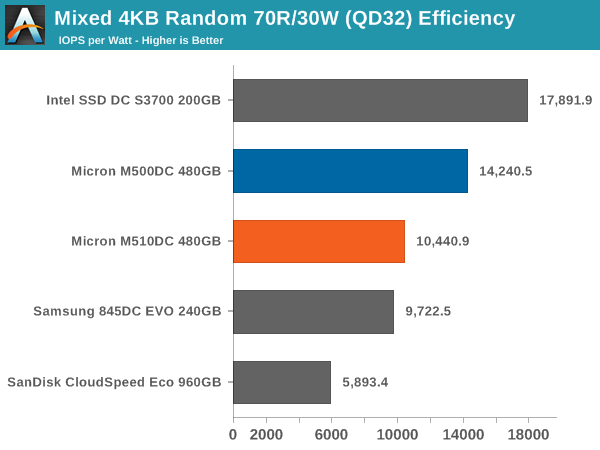
In power efficiency, however, the M510DC is very competitive and considerably better than the CloudSpeed Eco.
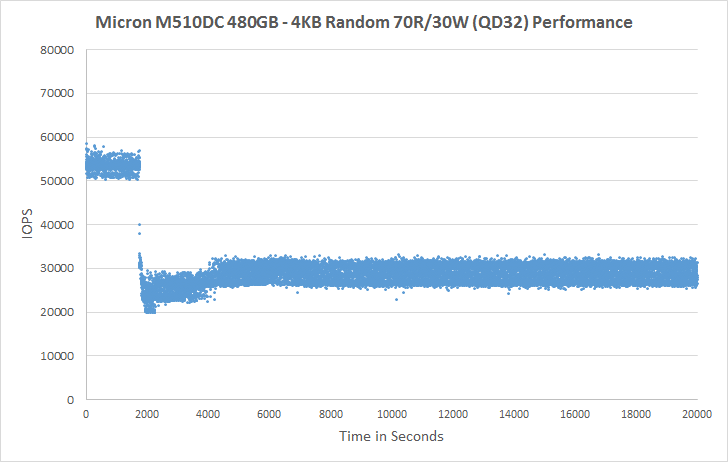 |
|||||||||
| Default | |||||||||
The M510DC is consistently inconsistent. It's not as bad as the M500DC, but given that the 845DC EVO provides better performance at much higher consistency it's hard to recommend the M510DC for applications that require very consistent mixed IO performance.
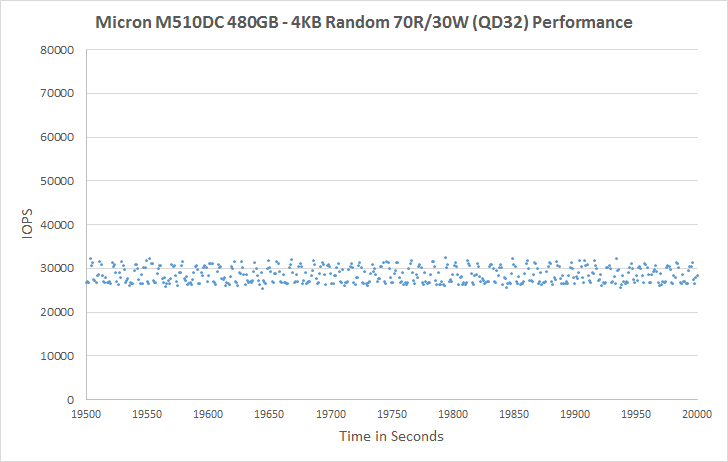 |
|||||||||
| Default | |||||||||
The same is also visible in the latency distribution. While the M510DC has frequent IOs in the range of 100µs, the consistency is again damaged by 3% of >10ms IOs. No other drive has IOs in that range, so it's a bit alarming given how even the CloudSpeed Eco consistently delivers IOs below 10ms.
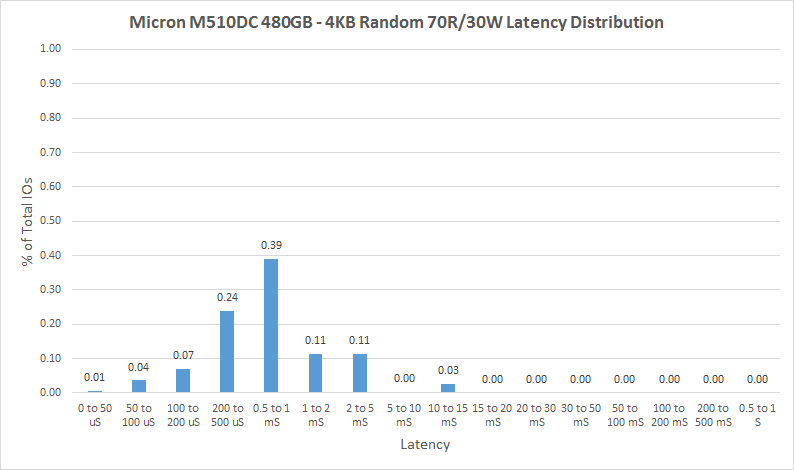 |
|||||||||
| Default | |||||||||


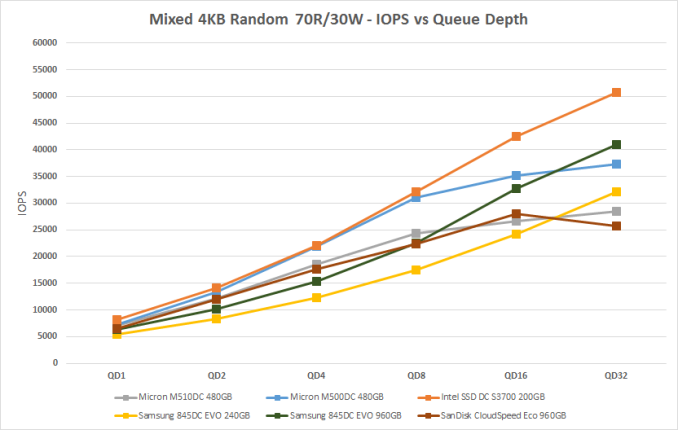
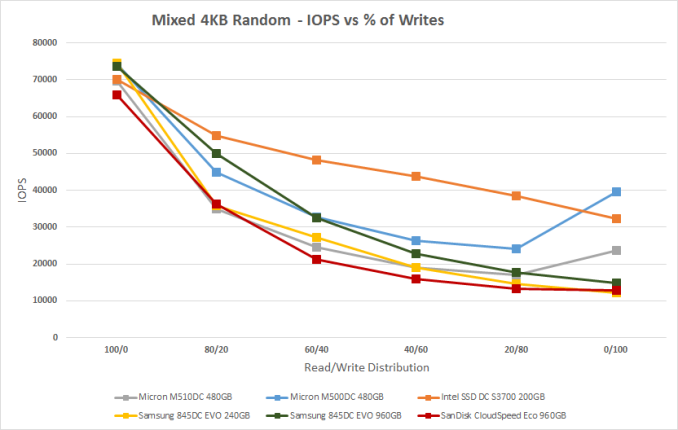








22 Comments
View All Comments
Oyster - Tuesday, July 21, 2015 - link
Maybe I missed it, but warranty information?twizzlebizzle22 - Tuesday, July 21, 2015 - link
Would there be warrenty information available for the same reason price wasn't?My question is how longevity is affected from 1-2 DWPD
Rekkx - Wednesday, July 22, 2015 - link
5 year or NAND wear out, whichever comes first.marraco - Tuesday, July 21, 2015 - link
I whish to have also the tests for non enterprise SSDs.These drives are not meant for the mass consumer, but enthusiasts like to try, or at least know how enterprise hardware performs on common PCs.
And is not the same to have "an opinion", even if valid, that actually knowing the experimental data.
Somebody will answer that, obviously, enterprise SSDs have different performance and workload targets, but that is no reason to discard consumer tests.
There is a big difference between actually knowing how they work, and just making an educated guess.
Also, enterprise users need to know how common hardware performs on server environments, because sometimes is cost effective to use common hardware for enterprise.
For example, Google used lots of common hardware on his servers, and that gave him a large advantage over older companies, with larger budgets.
Also, server hardware tends to have large validation and life cycles, and that means that it tends to have obsolete hardware. Sometimes is reasonable to use cheaper hardware, which can fail, but also has lower costs of replacement, or other benefits.
DanNeely - Tuesday, July 21, 2015 - link
Agreed. Also, as prices drop SSDs will be making their way onto client OS VM servers; and those will mostly see amped up versions of client workloads on them.ZeDestructor - Friday, July 24, 2015 - link
You say that, but I recently picked up two 800GB Intel DC S3500 SSDs for use in my desktop, since they were near enough to the 960-1TB consumer drives, but brought me the nice benefit of full power-loss protection, higher performance than the Crucal M500/M550/M600/MX200 (though I doubt i'll ever notice it), and at $300 each, were really not that far from the $275 I've seen the 960GB M500 go down to.nils_ - Friday, July 24, 2015 - link
It's also always interesting to see if the price differential for "DC" hardware is justified or if you're just paying up for the label.otherwise - Tuesday, July 21, 2015 - link
Any idea what those ridicluously large caps on the PCB are for? I would hope for better unexpected power failure recovery -- but didn't see anything in the article touting that as a feature.extide - Tuesday, July 21, 2015 - link
Yes that's what they are for, it mentions it on the first page.Flunk - Tuesday, July 21, 2015 - link
Your conclusion is based on the manufacturer's reported reliability rating, but you never tested it. Who's to say if this drive actually is more durable than it's competition? Or even a cheap consumer drive?I know that testing this would be impractical, but it's difficult to judge hardware based solely on the manufacturer's claims.